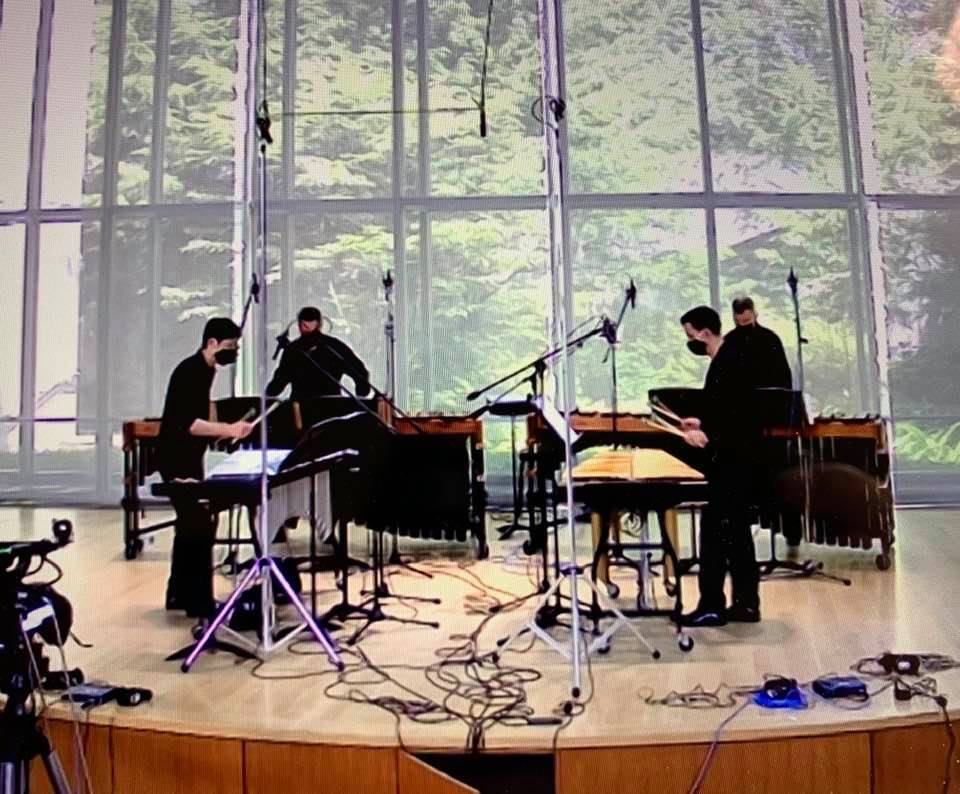by Nicholas Stevens

As Festival Music Director Alasdair Neale pointed out at the beginning of the video, the offerings consisted of two distinct types of quartet — one for cellos, and one for mallet percussion instruments — which met in the middle for a cello-marimba duo. Also moving from the 18th to the 21st century, the musicians made the most of this strong program from outer frame to beating heart.
This installment of the Festival featured commentary from Neale as well as visual direction by Creative Director James Darrah and Director of Photography Steve Condiotti. Their visuals served the first selection well — a cello quartet arrangement of Mozart’s Marriage of Figaro overture — and so did the playing of Amos Yang, Margaret Tait, Eric Gaenslen, and Jeremiah Shaw. Crisp, intense articulation, taut accents, and creamy legato phrases made the performance a gripping first offering, and the group’s uncannily tight synchronization belied their socially distanced seating arrangement.
When the cellists moved on to Handel’s “Ombra mai fu” from Serse, first player Amos Yang had a chance to sing like a world-class countertenor or mezzo, and took full advantage. The next composition took the quartet from the 18th to the 20th century, for a swinging rendition of The Beatles’ “When I’m 64.” Darrah and Condiotti chose a puzzling conceit: lights flashing onto the players, seated in near-darkness, as slow-motion close-ups interrupted. This did not prevent the performers from conveying their rich interpretation of the ubiquitous song.
Strings and mallets met when Marc Damoulakis and Si-Yan Darren Li appeared, in concert-black face masks, on the stage of the Cleveland Institute of Music’s Mixon Hall to perform Mariel by Golijov. The recording team made the pair sound wonderfully present, rich overtones coming through loud and clear. Li opted for a thin sound as he came in with a songlike melody over Damoulakis’s organic pulse, which shifted as harmonies washed ashore and receded. As Li’s tune ended with a dry, devastated drone that morphed into a snarl, Damoulakis led the way back into the opening material. The duo’s performance struck this writer right in the heart, given, as we all surely are these days, to moments when the deep trouble of current life floods back into consciousness after a merciful moment’s forgetting.
Damoulakis, now on vibraphone alongside Ian Ding with Joseph Tompkins and Thomas Sherwood on marimbas, took time to introduce Reich’s Mallet Quartet as an exercise in finely wrought counterpoint. The composer’s signature tactic of tricking the ear with interlocking and subtly shifting lines invited cinematography that floated around the ensemble — the camera tended to pause on Ding, among the more animated players at key moments in the piece.
Judicious pedaling on the parts of the vibraphonists ensured that ringing long tones and choked blips sounded completely distinct, as the marimbists sustained humming drones and spacey rhythms. Reich’s music remains that rarest of things in the canon of postwar classical music: an utterly transparent expression that speaks for itself. Fitting, then, that the only image to follow this performance was a title screen reading The End.
Published on ClevelandClassical.com August 12, 2020.
Click here for a printable copy of this article





